Diagnosing and fixing | Range Hood motor problems.
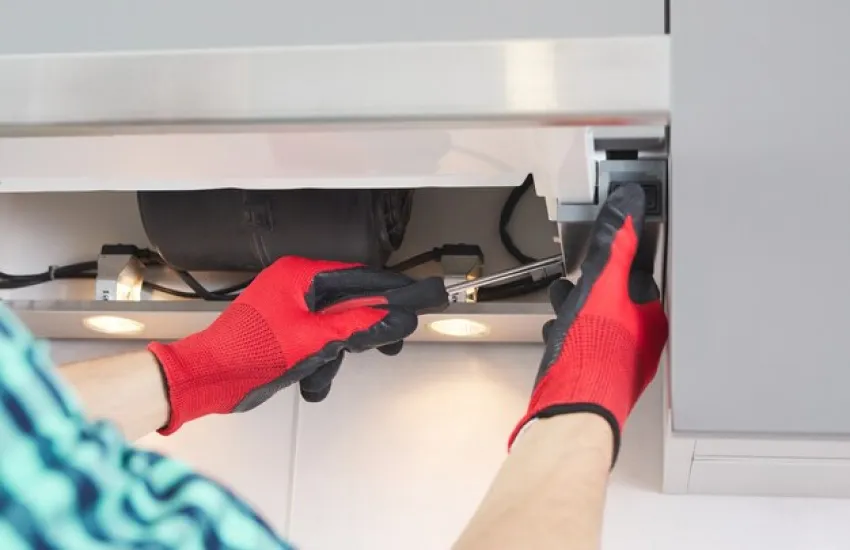
Range hood motor problems can cause poor ventilation, increased noise, and overall poor performance in your kitchen. Common issues include fan failure, weak suction, noisy operation, and inconsistent speeds. This guide will walk you through diagnosing and fixing motor problems with clear steps and practical solutions.
Diagnosing and fixing Range Hood motor problems.
Imagine preparing a meal, only to realize your range hood is no longer doing its job whether it’s not turning on, making strange noises, or just not pulling the smoke and odors out as it should. Range hood motor issues are not only frustrating but can compromise air quality in your kitchen. A malfunctioning motor could be the culprit behind weak suction, inconsistent speeds, or even a complete failure to spin. The good news? Most motor problems can be fixed with a little troubleshooting and repair.
Your fridge is a kitchen superstar as it keeps all your food fresh and drinks cold.
But does the fridge feel warm when you open it?
Is there water all over the floor?
Fridge issues are the worst!
Symptoms of Motor Problems
When your range hood motor isn’t working properly, it can leave your kitchen air stagnant and unpleasant. Here are the most common symptoms that indicate a motor issue:
1. Fan Not Spinning
The most obvious sign of a motor problem is when the fan doesn’t spin at all, or it spins at an unacceptably slow speed. This could be due to an electrical fault, a damaged motor, or something blocking the fan’s movement.
2. Unusual Noises
A range hood that makes humming, rattling, or grinding sounds could be an indication of a motor issue. These noises typically signal that the motor’s bearings are worn or that debris is caught in the fan.
3. Weak Suction or Airflow
If the suction feels weaker than usual, even when the fan is running, the motor may be underpowered or have insufficient capacity for your kitchen’s ventilation needs.
4. Inconsistent Fan Speeds
Erratic fan speeds can be caused by a malfunctioning motor or a problem with the motor’s control switch, leading to inconsistent performance when adjusting the fan speed.
Diagnostic Steps
Before jumping to conclusions, it’s essential to troubleshoot the motor issue systematically. Follow these steps to accurately diagnose the problem:
1. Check Power Supply
The first step is always to ensure the range hood is receiving power.
- Verify the connection: Make sure the range hood is plugged into a working outlet.
- Inspect the circuit breaker: A tripped breaker could be cutting power to the motor. Reset the breaker if necessary.
- Test the outlet: Plug another appliance into the same outlet to confirm it’s supplying power.
2. Examine the Fan Switch
Faulty switches are often the culprit behind motor problems.
- Test with a multimeter: Use a multimeter to check if the fan switch is allowing current to flow when it’s turned on.
- Check for continuity: If the switch shows no continuity, it’s time for a replacement.
3. Inspect the Motor
Once power and switches are ruled out, it’s time to inspect the motor.
- Look for visible damage: Inspect the motor for any signs of overheating, burns, or visible wear.
- Listen for unusual sounds: Turn on the motor and listen closely for any irregular noises like grinding or rattling, which often point to worn bearings.
- Check for loose connections: Make sure the motor’s wiring is secure and not damaged.
4. Test Motor Functionality
To further test the motor:
- Spin the fan blades: Unplug the range hood and manually spin the fan blades to check for resistance or obstructions that may be preventing the motor from running smoothly.
- Use a multimeter: Test if the motor is receiving 120 volts. If it’s not, the problem could lie in the motor itself or the wiring.
Common Motor Issues and Solutions
Once you’ve identified the problem, here’s how to fix it:
1. Motor Not Spinning
This is often caused by dirt, debris, or damaged components.
- Clean the fan blades and housing: Over time, grease and dust buildup can block the fan from spinning freely. Clean the fan and motor housing to remove any buildup.
- Tighten any loose screws: Check the fan base and ensure all screws are secure.
- Replace the motor: If the motor is receiving power but still won’t spin, it may need to be replaced.
2. Noisy Operation
Unusual noises are typically caused by worn motor bearings or debris caught in the fan.
- Clean and lubricate the bearings: If accessible, apply lubricant to the motor bearings.
- Tighten loose components: Check for any loose screws or components that could cause vibrations.
- Remove debris: Inspect the fan blades for debris that could be causing noise.
- Realign or replace bent blades: Bent fan blades can cause imbalanced spinning and noise. If the blades are bent, they should be realigned or replaced.
3. Weak Suction
If the suction seems weak, it may not be a motor problem, but it’s worth checking.
- Clean or replace air filters: Clogged filters can obstruct airflow, reducing suction. Clean or replace the filters regularly.
- Inspect ductwork for obstructions: Look for any blockages or damage in the ducting that could reduce airflow.
- Verify the fan speed control: Test the control to ensure it’s working properly.
- Replace the motor: If the motor is underpowered or malfunctioning, it may need to be replaced.
4. Inconsistent Fan Speeds
Erratic fan speeds are often due to faulty wiring or issues with the motor control system.
- Test the fan control switch: Make sure the switch is functioning properly and is sending consistent signals to the motor.
- Inspect wiring connections: Check for loose or damaged wiring between the control panel and the motor.
- Replace the motor: If the motor is still exhibiting speed inconsistencies, it may need to be replaced.
Motor Replacement
If all else fails, it may be time to replace the motor. Here’s how to do it safely:
- Disconnect power: Always unplug the range hood before starting any repairs.
- Remove the fan assembly: Detach the fan blades and housing from the motor.
- Disconnect the wiring: Take note of the motor’s specifications (voltage, amperage, RPM) and disconnect the wiring from the old motor.
- Install the new motor: Purchase a compatible motor, and ensure proper wiring connections.
- Reassemble the fan: Put the fan assembly back together and test the motor to ensure proper operation.
Preventive Maintenance
To avoid future motor problems, keep your range hood in top condition by performing regular maintenance:
- Clean fan blades and housing regularly to prevent grease buildup.
- Inspect and clean filters monthly to maintain airflow.
- Check for loose screws and components during cleaning.
- Schedule annual professional inspections to catch potential issues early.
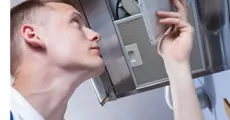
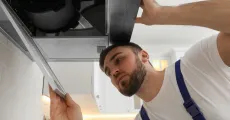
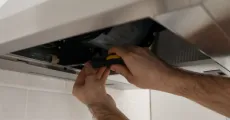
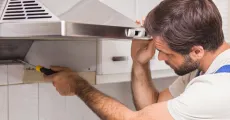

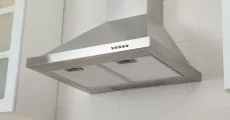
When to Seek Professional Help
While many motor problems can be diagnosed and repaired on your own, some situations require professional help. Consider calling CLT Appliance Repair if:
- You lack the necessary tools or expertise to handle electrical components safely.
- The issue involves complex circuitry or a damaged control board.
- The motor is under warranty, and you need an authorized technician to perform the repair.
Contact us today to handle all your kitchen range hood repair and keep your kitchen running smoothly!
FAQs
If the fan isn’t spinning, the motor could be damaged or obstructed. Check for dirt buildup, damaged wiring, or a faulty motor that may need replacing.
Noises like humming or grinding usually mean the motor bearings are worn, or there’s debris stuck in the fan. Cleaning and lubricating the motor can resolve this.
Clean or replace the air filters, check for ductwork obstructions, and test the motor. If the motor is underpowered, it may need to be replaced.
Motor replacement requires technical skill and electrical knowledge. If you’re unsure, it’s best to seek professional help to ensure safety and proper installation.
Don't let a malfunctioning Range Hood disrupt your daily life. Contact CLT Appliance Repair today at 704-606-9043 to schedule your Range Hood repair service.
We'll have your Range Hood back to optimal performance in no time!.

